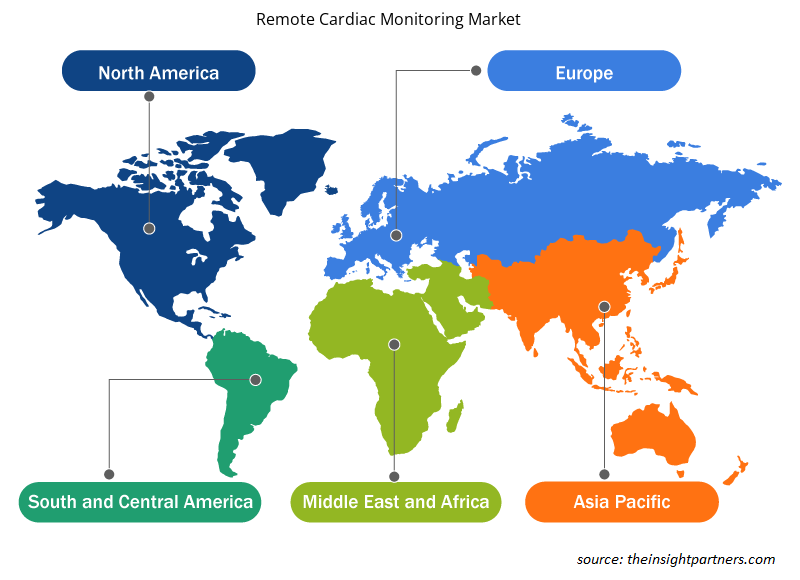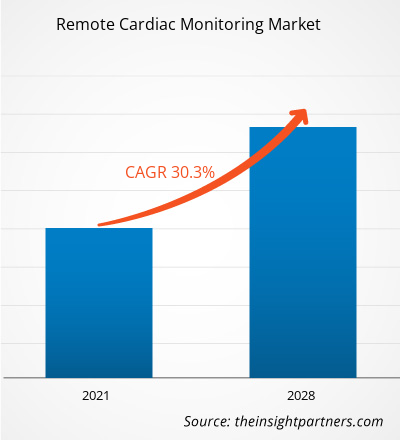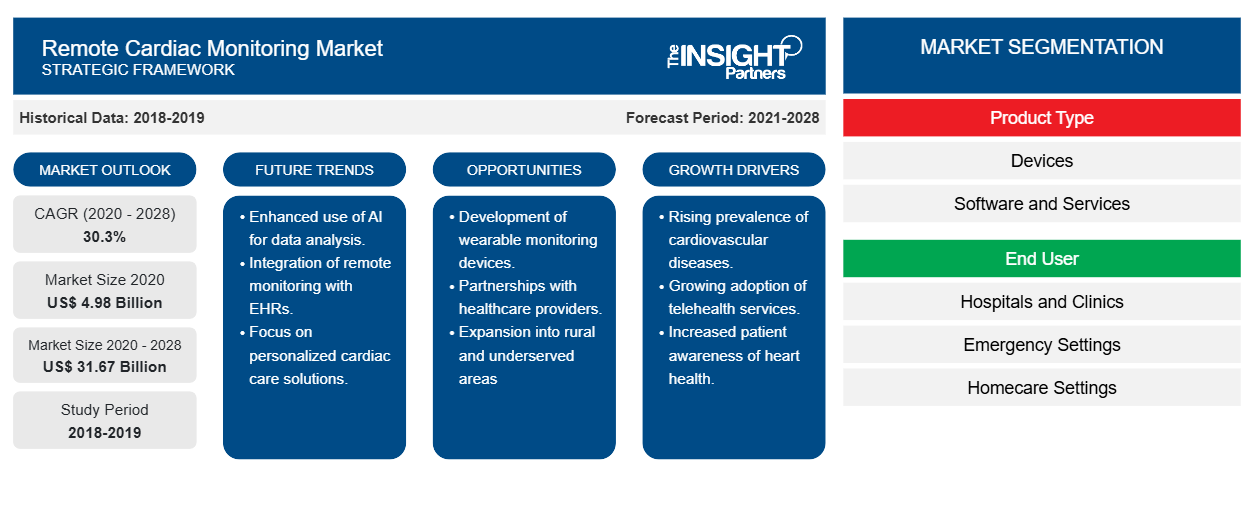遠隔心臓モニタリング市場は、2021年の49億7,640万米ドルから2028年には316億7,169万米ドルに達すると予測されており、2021年から2028年にかけてCAGR 30.3%で成長すると推定されています。
遠隔心臓モニタリング装置により、病院から離れた場所でも心臓の電気的活動を継続的にモニタリングできます。また、不整脈が疑われる患者や不整脈を発症するリスクのある患者の自宅での心電図 (ECG) モニタリングも可能になります。モニタリングは、患者が日常の活動に追われているときにも実行できます。したがって、遠隔心臓デバイス モニタリングの最も重要な利点の 1 つは、定期的な医師の診察の必要性が減ることです。ペースメーカーや植込み型除細動器などのデバイスは、低侵襲手術によって患者の心臓に埋め込まれます。デバイスと同期して動作する送信機がデータの送信を行います。心血管疾患 (CVD) の発生率の増加や遠隔医療アプローチの継続的な発展などの要因により、遠隔心臓モニタリング市場の成長が促進されています。ただし、データ プライバシーに関する懸念が市場の成長を妨げています。
要件に合わせてレポートをカスタマイズする
このレポートの一部、国レベルの分析、Excelデータパックなど、あらゆるレポートを無料でカスタマイズできます。また、スタートアップや大学向けのお得なオファーや割引もご利用いただけます。
-
このレポートの主要な市場動向を入手してください。この無料サンプルには、市場動向から見積もりや予測に至るまでのデータ分析が含まれます。
市場分析
心血管疾患の発症率の増加
遠隔患者モニタリング (RPM) により、患者は医療への関与を高め、健康をより適切に管理できるようになります。米国心臓協会は、エビデンスに基づく遠隔患者モニタリング技術の設計と使用を奨励する取り組みをサポートしています。世界保健機関 (WHO) によると、心血管疾患 (CVD) は世界中で主要な死因の 1 つであり、毎年約 3,000 万人が脳卒中を経験しています。米国心臓協会によると、米国の成人のほぼ半数が何らかの CVD を患っています。さらに、2035 年までに 1 億 3,000 万人以上、つまり米国人口の 45.1% が何らかの CVD を患うと予測されています。欧州心臓病学会の報告によると、CVD は欧州で 390 万人、欧州連合 (EU) で 180 万人以上の死因となっています。さらに、CVD は欧州の全死因の 45%、EU の全死因の 37% を占めています。アジア太平洋諸国におけるCVDによる死亡率は、タイ、フィリピン、インドネシアなどの国では20%未満であるのに対し、中国、香港、日本、韓国、マレーシアの都市部では20~30%となっています。さらに、ニュージーランド、オーストラリア、シンガポールなどでは、死亡率が30~35%と比較的高くなっています。
高血圧はCVDの重大な危険因子です。米国の成人における高血圧の年齢調整有病率は約35%で、人口約8,500万人に相当します。2035年までに、米国の成人の約42%、つまりさらに2,700万人が高血圧に罹患することになります。高血圧が経済に与えるコスト負担も増加しており、そのコストは2015年の約700億米ドルから2035年までに約1,500億米ドルに急増する可能性があります。遠隔患者モニタリングは、高血圧管理を改善し、急性高血圧関連イベントに起因する長期または頻繁な入院から生じる経済的負担を軽減するための重要な手段となる可能性があります。研究によると、(遠隔患者モニタリング)RPMは通常のケアと自己モニタリングのみと比較して収縮期血圧(SBP)と拡張期血圧(DBP)を大幅に下げることができます。いくつかの非ランダム化試験によると、RPM デバイスは、正確で早期の検出を可能にし、全死亡率と入院を減らすことで結果を改善できます。最近の臨床ガイドラインでは、脳卒中患者と非脳卒中患者の両方で心房細動 (AF) の検出に RPM を使用することを強く推奨しています。
製品タイプに基づく洞察
製品タイプに基づいて、遠隔心臓モニタリング市場はさらにデバイス、ソフトウェア、サービスに細分化されています。デバイスセグメントは2021年に大きな市場シェアを占め、予測期間中に高いCAGRを記録すると予想されています。
エンドユーザーベースの洞察
エンドユーザーに基づいて、遠隔心臓モニタリング市場は、病院と診療所、緊急設定、在宅ケア設定、その他に分類されます。病院と診療所セグメントは2021年に最大の市場シェアを占める一方、緊急設定セグメントの市場は予測期間中に31.60%のCAGRで成長すると予想されます。
遠隔心臓モニタリング市場で事業を展開するさまざまな企業は、製品の発売、合併と買収、コラボレーション、製品の革新、製品ポートフォリオの拡張などの戦略を採用して、世界中で事業展開を拡大し、ブランド名を維持し、エンドユーザーからの高まる需要に応えています。
遠隔心臓モニタリング市場の地域別洞察
予測期間を通じて遠隔心臓モニタリング市場に影響を与える地域的な傾向と要因は、Insight Partners のアナリストによって徹底的に説明されています。このセクションでは、北米、ヨーロッパ、アジア太平洋、中東およびアフリカ、南米および中米にわたる遠隔心臓モニタリング市場のセグメントと地域についても説明します。

- 遠隔心臓モニタリング市場の地域別データを入手
遠隔心臓モニタリング市場レポートの範囲
| レポート属性 | 詳細 |
|---|---|
| 2020年の市場規模 | 49.8億米ドル |
| 2028年までの市場規模 | 316.7億米ドル |
| 世界のCAGR(2020年 - 2028年) | 30.3% |
| 履歴データ | 2018-2019 |
| 予測期間 | 2021-2028 |
| 対象セグメント |
製品タイプ別
|
| 対象地域と国 |
北米
|
| 市場リーダーと主要企業プロフィール |
|
市場プレーヤーの密度:ビジネスダイナミクスへの影響を理解する
遠隔心臓モニタリング市場は、消費者の嗜好の変化、技術の進歩、製品の利点に対する認識の高まりなどの要因により、エンドユーザーの需要が高まり、急速に成長しています。需要が高まるにつれて、企業は提供内容を拡大し、消費者のニーズを満たすために革新し、新たなトレンドを活用し、市場の成長をさらに促進しています。
市場プレーヤー密度とは、特定の市場または業界内で活動している企業または会社の分布を指します。これは、特定の市場スペースに、その市場規模または総市場価値に対してどれだけの競合相手 (市場プレーヤー) が存在するかを示します。
遠隔心臓モニタリング市場で事業を展開している主要企業は次のとおりです。
- OSIシステムズ株式会社
- GEヘルスケア
- バイオトロニックSe
- 日本光電株式会社
- アボットラボラトリーズ
免責事項:上記の企業は、特定の順序でランク付けされていません。

- 遠隔心臓モニタリング市場のトップキープレーヤーの概要を入手
遠隔心臓モニタリング市場 – 製品タイプ別
- デバイス
- ソフトウェア
- サービス
遠隔心臓モニタリング市場 – エンドユーザー別
- 病院と診療所
- 緊急設定
- ホームケア設定
- その他
遠隔心臓モニタリング市場 – 地域別
-
北米
- 私たち
- カナダ
- メキシコ
-
ヨーロッパ
- フランス
- ドイツ
- イタリア
- 英国
- スペイン
- その他のヨーロッパ
-
アジア太平洋(APAC)
- 中国
- インド
- 韓国
- 日本
- オーストラリア
- その他のアジア太平洋地域
-
中東・アフリカ(MEA)
- 南アフリカ
- サウジアラビア
- アラブ首長国連邦
- その他の中東およびアフリカ
-
南米および中米(詐欺)
- ブラジル
- アルゼンチン
- 南米および中米のその他の地域
企業プロフィール
- OSIシステムズ株式会社
- GEヘルスケア
- バイオトロニックSe
- 日本光電株式会社
- アボットラボラトリーズ
- ボストン・サイエンティフィック・コーポレーション
- フィリップスNV
- ハネウェルインターナショナル株式会社
- AMCヘルス
- 過去2年間の分析、基準年、CAGRによる予測(7年間)
- PEST分析とSWOT分析
- 市場規模価値/数量 - 世界、地域、国
- 業界と競争環境
- Excel データセット
最新レポート
お客様の声
購入理由
- 情報に基づいた意思決定
- 市場動向の理解
- 競合分析
- 顧客インサイト
- 市場予測
- リスク軽減
- 戦略計画
- 投資の正当性
- 新興市場の特定
- マーケティング戦略の強化
- 業務効率の向上
- 規制動向への対応























 無料サンプルを入手 - 遠隔心臓モニタリング市場
無料サンプルを入手 - 遠隔心臓モニタリング市場